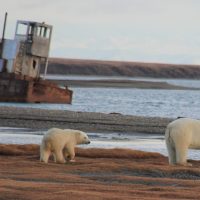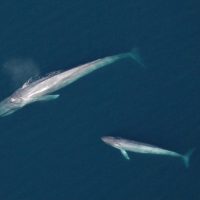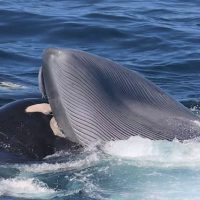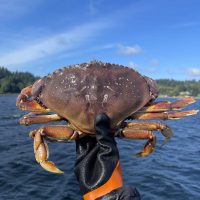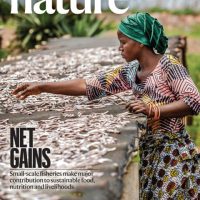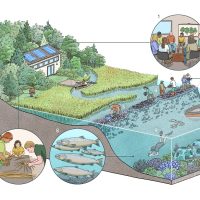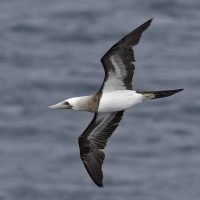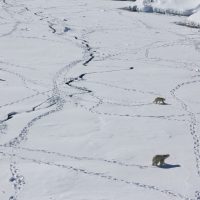Filter Results
Scientists pilot a new method to measure the health of wild polar bears
Climate change threatens the health of polar bears across the Arctic. A study published in Conservation Physiology on March 5, introduces a new approach to measuring the health of polar bear populations, drawing inspiration from a well-known concept in human medicine: allostatic load. The lead author of the study is SAFS PhD student, Sarah Teman, working with UW Professor, Kristin Laidre, and scientists from USGS and Fish and Wildlife Health Consulting.
Read moreUnravelling the mystery of the missing blue whale calves
Only two blue whale births have ever been recorded in human history, an extraordinary mystery given they give birth every two to three years. Calves are also only rarely sighted—far less than would be expected from their pregnancy rates. Calves closely follow their moms and are sighted as mother-calf pairs, but why are so few detected? A new UW study by Trevor Branch proposes why. Its explanation hints at when and where the unseen births are happening and where blue whale calves spend their earliest months.
Read moreGhostly flight species of baleen whales avoid attracting killer whales by singing too low to be heard
Killer whales are the only natural predator of baleen whales. More solitary than toothed whales, baleen whales face predatory attacks from killer whales, especially mother and calf pairs. When attacked, some species fight back, while others choose flight. But whale species also produce loud underwater songs…what stops killer whales from homing in on their calls and attacking them? New acoustic research by Trevor Branch sheds light on why.
Read moreA Crab Network is Connecting Communities and Generating Crucial Data for Salish Sea Fisheries
A collaborative network of agency and tribal scientists and resource managers, university faculty and students, and community volunteers are diligently working together to unlock the secrets of the Dungeness crab’s life cycle in the Salish Sea. The Pacific Northwest Crab Research Group (PCRG) is leading this unprecedented effort, generating vital data and fostering robust relationships to ensure the long-term sustainability of this ecologically, economically and culturally-important species.
Read moreSmall-scale fisheries essential to global nutrition, featured on cover of Nature
Small-scale fisheries play a significant but overlooked role in global fisheries production and are key to addressing hunger and malnutrition while supporting livelihoods around the world, according to research featured in Nature in Jan. 2025. The study was published by an international team of scientists, including Professor Chris Anderson from the UW SAFS.
Read moreBeyond despair: How can ecosystem restoration enhance human wellbeing?
Ecosystem restoration has historically had a very ecological focus. However, while teaching a special interdisciplinary class during her time at Duke University, SAFS Assistant Professor, Carter Smith, took a slightly different view: how can ecosystem restoration be used to directly improve human wellbeing?
Read moreEvolution and elongation in deep dwelling anglerfishes
Working with specimens from the Burke Museum and NOAA, Elizabeth Miller, a former postdoc at SAFS, was captivated by the great diversity of shapes of anglers, which was at odds with how the species is often depicted in popular culture (think Finding Nemo). Elizabeth set out to build a family tree of anglerfishes and delve into the evolution of new shapes, such as body elongation.
Read moreFrom tropics to temperate: The shifting breeding ranges of seabirds amid climate change
Across the globe, species are shifting their ranges in response to environmental changes driven by climate change. However, seabirds face distinct challenges in adapting to these shifts. Amelia DuVall, PhD candidate at SAFS and member of the Washington Cooperative Fish and Wildlife Research Unit, recently published a paper reporting on the breeding range expansion of two pantropical seabird species—the Brown Booby and the Blue-footed Booby.
Read moreOne or many? Exploring the population groups of the largest animal on Earth
Hunted nearly to extinction during 20th century whaling, the world’s largest animal, the Antarctic blue whale, went from a population size of roughly 200,000 to little more than 300. The most recent abundance estimate in 2004 put Antarctic blue whales at less than 1% of their pre-whaling levels. But is this population recovering? Is there just one population of Antarctic blue whales, or multiple? Why do these questions matter for conservation? PhD student, Zoe Rand, is tackling these questions in a new study.
Read morePaws of polar bears sustaining ice-related injuries in a warming Arctic
Polar bears in some parts of the high Arctic are developing ice buildup and related injuries to their feet, apparently due to changing sea ice conditions in a warming Arctic. While surveying the health of two polar bear populations, researchers led by Kristin Laidre from UW SAFS, found lacerations, hair loss, ice buildup and skin ulcerations primarily affecting the feet of adult bears as well as other parts of the body.
Read more